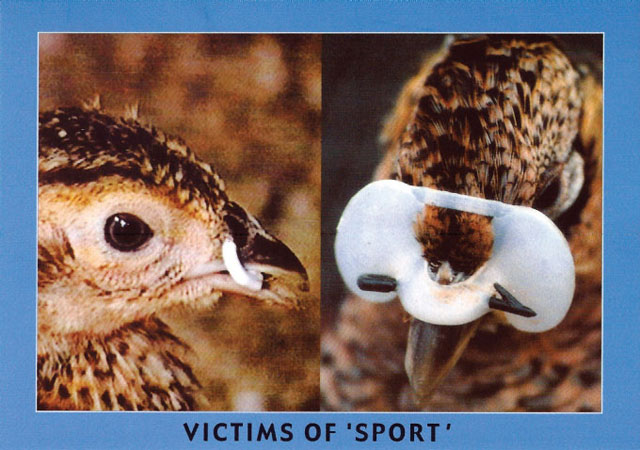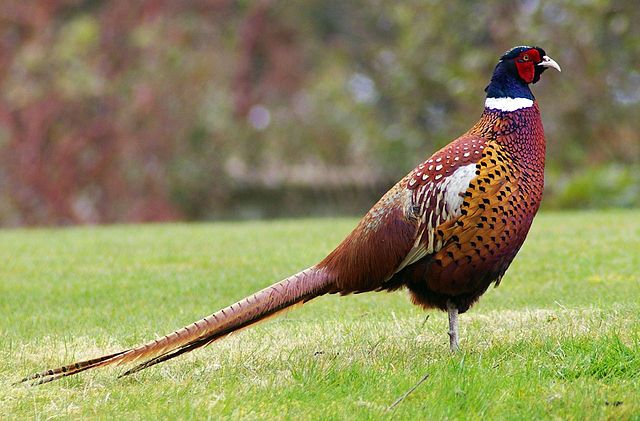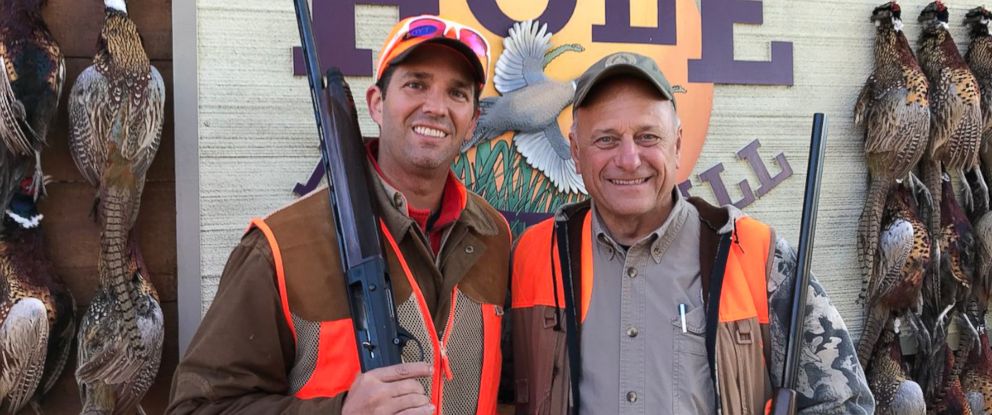Donald Trump Jr. Goes Pheasant Hunting in Iowa This Weekend
“One of my uncles loved to tell the story about how he threw away twenty pheasant pies his wife had baked.” – Karen Davis, “From Hunting Grounds to Chicken Rights,” Sister Species, p. 129
I grew up in a family and community in Pennsylvania where sport hunting was normal and expected for men and boys. Among other small animals he injured and killed and taught my brothers to do, my father and his friends gunned down ring-necked pheasants for recreation.
A pheasant “hunt” is no more a hunt than is seal clubbing – an event I observed in March, 1974, on a visit to Canada’s Grindstone Island, where the islanders beat newborn seals to death not just for the fur trade or “survival,” but for fun.
Scientifically, birds known as pheasants include chickens, turkeys, peafowl, quails, guinea fowl and pheasants. A common feature of these birds is that, except for the turkey, none are native to Europe. Pheasants and chickens are native to Asia. Another common feature is that these birds make their nests on the ground instead of on ledges or in trees.
Growing up in Pennsylvania I watched my father and other men standing in the kitchen in the early morning decked in bright orange, talking about the great day of killing that lay ahead. They’d load the dogs yelping into the car trunk, slam it shut, and off they went.
Once, after I learned what pheasant “hunting” really means, I went for walk in the woods with my father and one of my brothers the day before the first day of “pheasant season.” They were discussing their visit earlier that morning to the pheasant farm that would release the hand-reared pheasants for recreational killing the following day. My brother said to my father about that visit, “I just wish I had had my gun.” He wished he could shoot the birds while they were still in the pens, before the canned hunt in the woods had even begun.
The great English writer Thomas Hardy devotes three pages of his novel Tess of the D’Urbervilles, set in the 19th century, to describing the rural pastime of pheasant hunting in the English countryside, noting how in the autumn and winter, men “made it their purpose to destroy life – in this case harmless feathered creatures, brought into being by artificial means solely to gratify these propensities.” He describes Tess’s discovery of the pheasants as she herself is being hunted down, when she hears at night “a new strange sound among the leaves.” The next morning she sees that
“Under the trees several pheasants lay about, their rich plumage dabbled with blood; some were dead, some feebly twitching a wing, some staring up at the sky, some pulsating quickly, some contorted, some stretched out – all of them writhing in agony, except the fortunate ones whose tortures had ended during the night by the inability of nature to bear more.”

In her chapter “The Sporting Life,” in Chickens’ Lib: The Story of a Campaign, Clare Druce draws attention to the game bird industry. Victims of the tradition of organized bird-shooting parties, pheasants and other avian species targeted for assault are debeaked and fitted with clamps, spectacles, and other sociopathic devices that, added to the squalor in which they are raised for the massacre that awaits them, result in inflamed nostrils and beaks, septicemia, arthritis, brain disease, tumors, blindness, chronic pain, terror and other pathologies duly reported in the Veterinary Record, the weekly journal of the veterinary profession.
It isn’t just Britain, of course. As Druce writes on page 232: “Most of our knowledge about game birds has been based on practices in the UK, but while writing this chapter I’ve looked at various websites. One day I lit upon a hauntingly sad image from America. A sturdy leather harness encircles a live pheasant as she lies helpless on the grass, denied any hope of movement, let alone escape. The device comes in different sizes to suit different types of birds, including the tiny quail, and is an aid for training gun dogs.”
Pheasant Breeding Program in New York State
New York State Department of Environmental Conservation
It isn’t just England, Iowa, Pennsylvania, or Utah. The New York State Department of Environmental Conservation runs a program, announced as follows in 2017:
Applications for Cooperative “Raise and Release” Program Due by March 25The opening of the application period for the cooperative Day-Old Pheasant Chick Program to enhance opportunities for pheasant hunting in New York has begun, the State Department of Environmental Conservation (DEC) announced today.
The program provides pheasant hunting opportunities through a partnership among DEC, sportsmen and sportswomen, 4-H youth groups, and landowners interested in rearing and releasing pheasants. The program is funded through the State Conservation Fund, which is supported by license fees paid by hunters, trappers, and anglers.
The Day-Old Pheasant Chick Program began in the early 1900s, when pheasant eggs and chicks were distributed to farmers and rural youth. Today, day-old chicks are available at no cost to participants who are able to provide a brooding facility, a covered outdoor rearing pen, and an adequate release site.
Daily care is necessary to monitor the health of the birds and to ensure there is adequate feed and water for the rapidly growing chicks. The pheasants may be released when they are eight weeks old and no later than Dec. 1. Approved applicants will receive the day-old chicks in April, May, or June. All release sites must be approved in advance by DEC and must be open for public pheasant hunting opportunities.
In 2016, DEC distributed more than 34,000 day-old pheasant chicks to qualified applicants. Individuals interested in this program should contact the nearest DEC regional wildlife office for applications and additional information (see information below). Applications must be filed with a DEC regional wildlife manager by March 25. A “Pheasant Rearing Guide” and applications are also available on DEC’s website.
In the U.S. so far, little or no attention has been paid by animal advocacy organizations to the sadistic “sport” of pheasant hunting. The birds are intentionally bred and captive-raised by U.S. government agencies at the state level for the sole purpose of gratifying the instincts of people like Donald Trump, Jr., and others for whom torturing, injuring, and killing these birds puts a smile on their faces and a swell of some sort of pride.
Learn More:

A male pheasant, born for the sole purpose of being blasted for fun with a shotgun.
